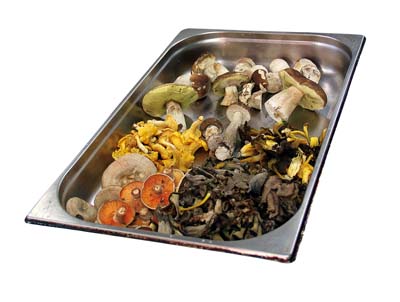Country Life TV: How to forage for wild food
Fraser Christian takes us along the Dorset coastline to see what wild food can be found in autumn from wild spinach to rosehips


When you spend time with a dedicated forager, you quickly discover that almost any growing thing to be found in our hedgerows, forests or fields has some nutritional or medicinal merit. It's astounding when one starts to learn how hunter-gatherers used naturally occurring plants in place of all the products that we rely upon today from the chemist and the supermarket.
Foraging was about survival for our pre-decessors, but today, happily, we can feel confident that we know where our next supper is coming from. It is, however, still enormous fun to supplement familiar recipes with a few foods one finds oneself-not to mention discovering how much more flavoursome smaller wild fruit and vege-tables can be. It's also a great way of spending the day with younger family members, as even toddlers can reap the rewards.
Of course, we all foraged without thinking when we were little, meandering slowly to a friend's house on foot, grazing on brambles along the way, and arriving for lunch with purple-stained fingers as proof of guilt. Most of us knew where to find the more obvious fruits and berries locally, and still do, but a little more knowledge opens up a whole new world of potential ingredients.
Wild food can be found throughout the year, but autumn is a great time to venture out: the hedgerows are brimming with fruit, and the fields and forests are full of mushrooms, although aficionados will tell you foraging is extremely unpredictable. For instance, last year was a terrific year for penny buns (porcini), hundreds of which carpeted the New Forest in September and October.
The word spread, and, for a few weeks, carloads of Italian families drove regularly down from London to comb the forest floor and picnic expansively at lunchtime. This year, however, is completely different-everything is early and there are nowhere near as many penny buns. There are plenty of theories as to why, and, of course, the weather is the major influence, but, fortunately, the fun for the amateur forager is as much the joy of stumbling upon an unexpected find as it is cleverly predicting a windfall.

A good way to begin with confidence is to find yourself an expert. Some country-house hotels have foragers who provide this service to guests, and one such place is The Pig, just outside Brockenhurst in the New Forest. Their forager, Garry Eveleigh, has been collecting wild food since he was a boy. An expert fisherman, Mr Eveleigh's grand passion is, in fact, mushrooms, which thrive in the area. He shared tips on finding certain species (‘where there are millers [a white mushroom], there are ceps'), and the right way to harvest mushrooms. He showed us how to spot maggots in old mushrooms, and cautioned everyone but the most well-versed people against picking their own.
‘Take your camera out with you, and take pictures of what you find. Go home and see whether you can identify them correctly. Don't pick what you don't recognise-and never, ever pick something you're not going to take home.' Mark down two or three extremely well-known species that grow nearby to focus on. ‘And if there is even the tiniest flicker of doubt in your mind, don't pick it.' We found a wonderful mixture of porcini on our afternoon foraging, as well as winter chanterelles, hedgehog mushrooms, trompettes de la mort and birch boletes, all of which went to The Pig's kitchen for that evening's restaurant sitting they were delicious, simply pan-fried on toast.
Exquisite houses, the beauty of Nature, and how to get the most from your life, straight to your inbox.
Further along the coast, in Dorset, is Fraser Christian from www.wildforage.co.uk, who led us to horseradish and wild spinach on the beach, as well as tiny wild carrots, field mushrooms, hawthorn, gorse, brambles, rosehips and, of course, sloes. He cautioned us that we should never take more than is fair, as birds and animals need wild food to survive. ‘I never take more than one-third of what's there,' he says.
And how do you know when sloes are ready to pick? ‘When the birds start getting stuck in.' Waiting for the first frost before picking sloes is a myth he dispels: ‘It's just as easy to pick sloes when they're ripe and put them in the freezer for a few hours. It has the same effect, and you get your share before the birds take the lot.'
Foraging for beginners
* You'll need: an old wicker basket to allow foraged fruits to breathe, a legal folding knife under three inches long, trusty wellies and a book with pictures
* Don't pull plants up by the roots, with the exception of most mushrooms. They can be pulled up in their entirety-heavy rains can cause left roots to rot
* Don't take away more than one-third of a ‘community' of something
* The availability of foodstuffs will depend on where you live. Access to several habitats widens the range of things you might see, and the further north you live, the later the wild foods will ripen
* What you can take depends on where you are. In general, stick to public rights of way and make sure you have the landowner's permission. In national parks and on National Trust land, there are particular rules-for instance, some don't allow you to pick flowers, which means herbs such as wild mint are disallowed
* If you're planning on foraging in rivers, contact the Environment Agency, which can guide you as to what to catch. The right to catch shellfish and crustacea is enshrined in common law, but certain rules apply. Check with your regional Sea Fisheries Committee
How to forage: Country Life video guide to autumn foraging on the coastline
